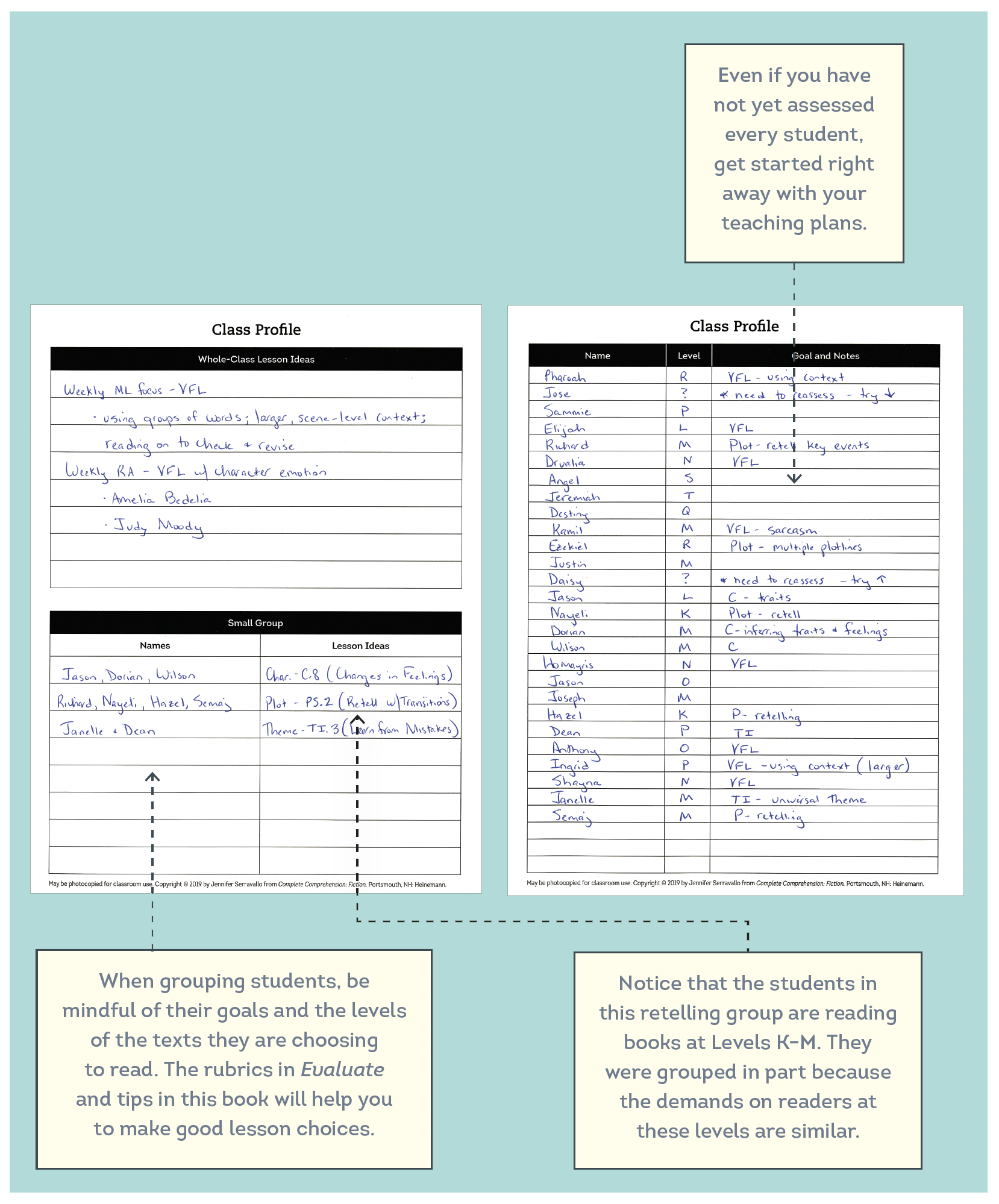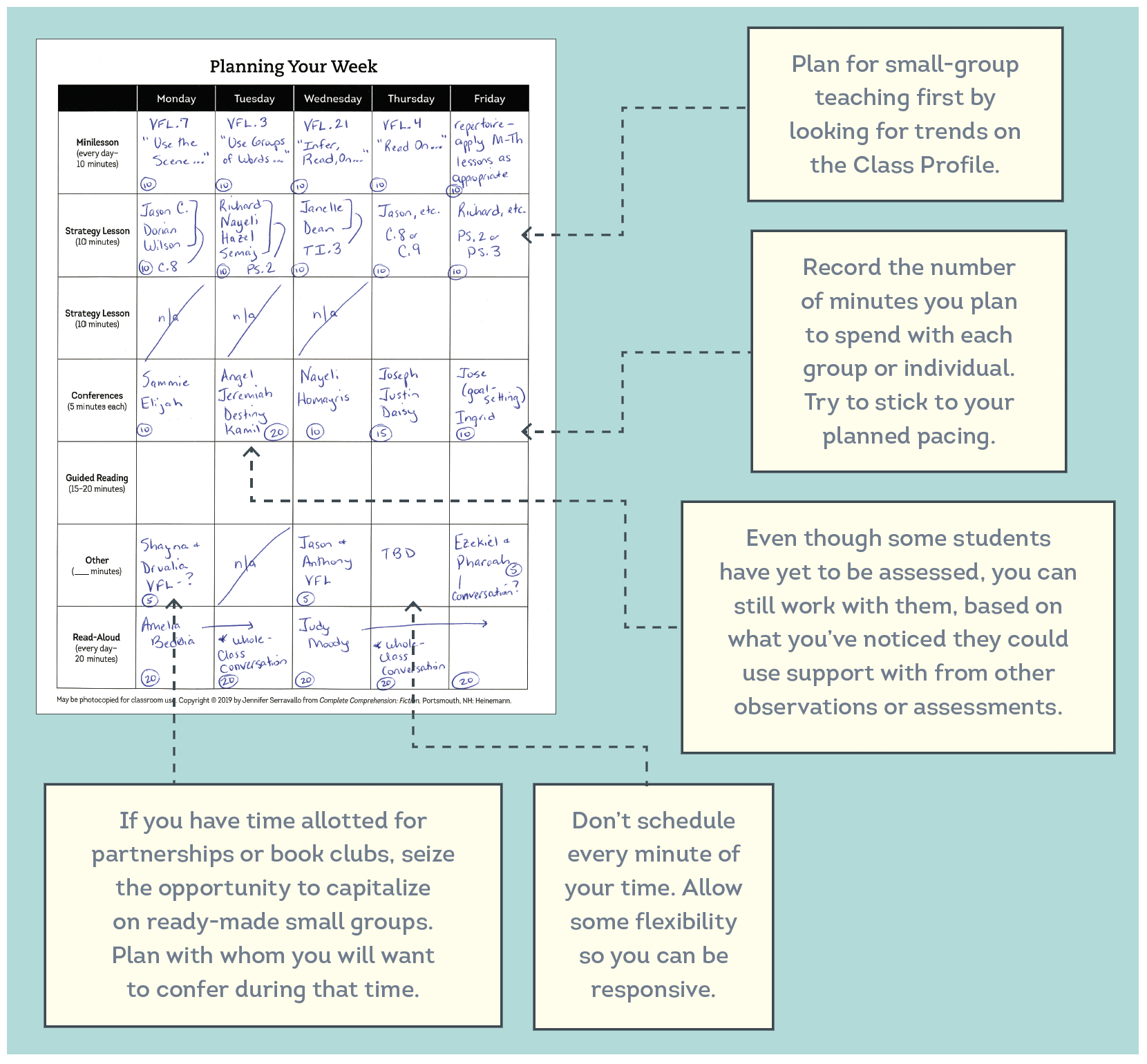
With Complete Comprehension, Jennifer Serravallo has created a simple, powerful way to utilize authentic, full-length trade books in assessment. With an intuitive Assess→Evaluate→Teach framework, teachers can deeply understand each child’s comprehension and plan strategies-based instruction to support their progress.
With Complete Comprehension, Jennifer Serravallo has created a simple, powerful way to utilize authentic, full-length trade books in assessment. With an intuitive Assess→Evaluate→Teach framework, teachers can deeply understand each child’s comprehension and plan strategies-based instruction to support their progress.
In the Assess phase, students read a chapter book or nonfiction picture book of their choice independently, answering questions as they go. In the Evaluate phase, their teacher then spends about 10 minutes evaluating the responses using a book summary and rubrics included in the resource. From this evaluation, teachers are able to pinpoint a goal and specific skills that students need support with leading to the most important phase: Teach. Using the Teach books, each with over 100 strategies, and the online resources showing videos of small group, whole class, and individual teaching, teachers are equipped with support to address every student’s goal all year long no matter the way the literacy block is structured.
Below, you’ll find Jen's answers to some of the most frequently asked questions about the teaching phase of Complete Comprehension, excerpted from the Teach book included with the resource.
Q. How can I plan for teaching over time?
Once your students know their goals, you’ll be ready to plan for ongoing instruction. My first recommendation is to try to see your class at a glance using a simple form, like the Class Profile form.. On this form, record your class list, the text level each student reads, and the primary goal you want to work toward with each student. This enables you to identify students with common goals. You can also think through whole-class lesson ideas and small-group lesson ideas and then record them at the bottom of the form.

Grouping Readers In general, when I group students, I am less concerned about them all reading books at the same level than I am about whether the strategies I choose are applicable to all of them. Browse the 100+ lesson ideas included in this resource, most of which are appropriate for students reading books of any level. Those strategies that are best for a particular level range (e.g., J–M or N–R) are indicated as such.
Planning Your Week Now it is time for the detailed planning of your week. I plan on a daily whole-class interactive read-aloud lesson and a minilesson. The read-aloud typically lasts about twenty minutes, and I use one or a small handful of teaching ideas during that time.

The minilesson typically lasts about ten minutes, during which time I focus on just one specific strategy that would benefit most of my students. You might choose small-group lesson topics based on student goals, as a result of Complete Comprehension or other assessments, or possibly use that time to support goals from your reading curriculum.
Strategy lessons, one-on-one conferences, small-group read-alouds, and guided reading are the places where I differentiate instruction. How many of these structures I use each day will vary based on the needs of my class. For example, if many of my students have common goals, then I’ll support them with those during the whole-class minilessons. If most of my students’ goals are unique, and the range of levels of books they are reading is wide, then I’ll probably do lots of one-on-one conferring. Also, each week might look a little bit different, again, based on the needs of my class. One week I may find myself doing many strategy lessons, and the next week mostly one-on-one conferences. As a rule of thumb, I try to see every student in a one-on-one conference at least twice a month and to see every student either in a small group or one-on-one at least twice a week. In all/any of these teaching structures you can use the strategies and lessons provided within this resource.
I enter students’ names onto the Planning Your Week form, starting with those who have common goals and are reading similar levels of text, and organize them for small-group lessons. Then I add the names of students for partnership and book club conferences. Finally, I record who I plan to see for individual conferences. I keep an eye on how much time I’ve allotted for all of my conferences and small groups.
Q: How do I choose model texts for teaching?
Almost any text can work as a model text in your lessons. A good rule of thumb, however, is to choose one that is familiar to you and your students. That way, students will be able to focus on the lesson topic rather than on working to figure out the content of the book. Short texts (picture books, short stories, or excerpts from novels) are great to use as models, since they allow you to zoom in on a bit of text that elucidates your teaching point. However, do not use books that are part of this kit, because they may be used later by some students during assessment, and studying the text as a class may give you a false read on how much a student is able to understand independently, without instructional support.
Q: While I’m working with students in small groups and conferences, what is the rest of the class doing?
I’m convinced that reading is the best activity for students to be engaged in while you’re doing your differentiated instruction. Not centers, not worksheets, not writing responses—reading! Ideally, that reading is of their own choosing and is a text they can read with accuracy, fluency, and comprehension. This will help in more ways than one:
- First, it allows students time to practice the strategies you’ve taught them, which will help them reach their individual goals.
- It allows students to work on their stamina and read a high volume of texts. Voluminous reading supports student growth.
- It frees you up to immerse yourself fully in the work of supporting individuals and groups. In a typical reading block of thirty-five to forty minutes, I try to support about ten readers. I can’t be that focused or productive if I’m trying to manage what the other readers in the class are doing; they need to be taught to read and work independently toward their goals.
Q: What’s the best way to keep track of my assessments and teaching over time?
I recommend that you establish a note-taking and record keeping system—one that makes sense to you and that you are able to use and maintain easily. I like to be able to see each child’s learning over time at a glance. So I keep a separate folder for each student, in which I store all my individual assessments, along with anecdotal records I write during conferences and small-group lessons.
Other teachers find it helpful to create a notebook or section in a binder for each student, or store notes in a bin or file. When it comes time to meet with a particular student for a conference or in a small group, you can simply pull the notebook/folder/binder from its storage space and bring it to wherever the teaching is happening. Keeping notes this way also allows you to share them with other teachers who work with your students (e.g., English as a second language teachers, resource room teachers, intervention specialists).
Some teachers prefer taking notes online or with apps such as Google Drive, Pensieve, Confer, or Evernote. If utilizing an online note-taking system, it will be important to find one that has cloud-based storage to allow any teacher who is working with a student to access their notes.


